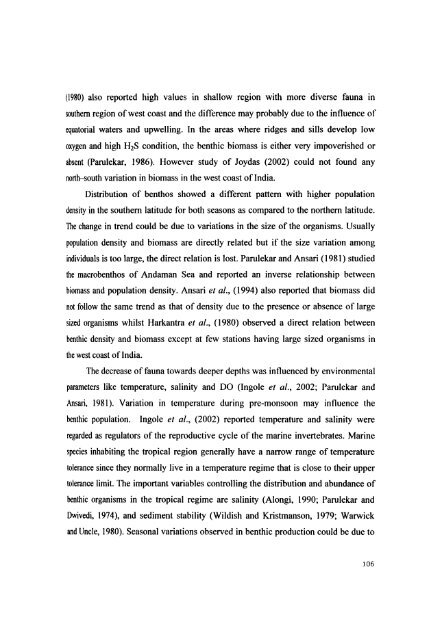L - Cochin University of Science and Technology
L - Cochin University of Science and Technology
L - Cochin University of Science and Technology
Create successful ePaper yourself
Turn your PDF publications into a flip-book with our unique Google optimized e-Paper software.
(1980) also reported high values in shallow region with more diverse fauna in<br />
southern region <strong>of</strong> west coast <strong>and</strong> the difference may probably due to the influence <strong>of</strong><br />
equatorial waters <strong>and</strong> upwelling. In the areas where ridges <strong>and</strong> sills develop low<br />
oxygen <strong>and</strong> high H 2S condition, the benthic biomass is either very impoverished or<br />
absent (Parulekar, 1986), However study <strong>of</strong> Joydas (2002) could not found any<br />
north-south variation in biomass in the west coast <strong>of</strong> India.<br />
Distribution <strong>of</strong> benthos showed a different pattern with higher population<br />
density in the southern latitude for both seasons as compared to the northern latitude.<br />
The change in trend could be due to variations in the size <strong>of</strong> the organisms. Usually<br />
population density <strong>and</strong> biomass are directly related but if the size variation among<br />
individuals is too large, the direct relation is lost. Parulekar <strong>and</strong> Ansari (1981) studied<br />
the macrobenthos <strong>of</strong> Andaman Sea <strong>and</strong> reported an inverse relationship between<br />
biomass <strong>and</strong> popUlation density. Ansari et aI., (1994) also reported that biomass did<br />
not follow the same trend as that <strong>of</strong> density due to the presence or absence <strong>of</strong> large<br />
sized organisms whilst Harkantra et al., (1980) observed a direct relation between<br />
benthic density <strong>and</strong> biomass except at few stations having large sized organisms in<br />
the west coast <strong>of</strong> India.<br />
The decrease <strong>of</strong> fauna towards deeper depths was influenced by environmental<br />
parameters like temperature, salinity <strong>and</strong> DO (Ingole et al., 2002; Parulekar <strong>and</strong><br />
Ansari, 1981). Variation in temperature during pre-monsoon may influence the<br />
benthic popUlation. Ingole et al., (2002) reported temperature <strong>and</strong> salinity were<br />
regarded as regulators <strong>of</strong> the reproductive cycle <strong>of</strong> the marine invertebrates. Marine<br />
species inhabiting the tropical region generally have a narrow range <strong>of</strong> temperature<br />
tolerance since they normally live in a temperature regime that is close to their upper<br />
tolerance limit. The important variables controlling the distribution <strong>and</strong> abundance <strong>of</strong><br />
benthic organisms in the tropical regime are salinity (Alongi, 1990; Parulekar <strong>and</strong><br />
Dwivedi, 1974), <strong>and</strong> sediment stability (Wildish <strong>and</strong> Kristmanson, 1979; Warwick<br />
<strong>and</strong> Uncle, 1980). Seasonal variations observed in benthic production could be due to<br />
106

















